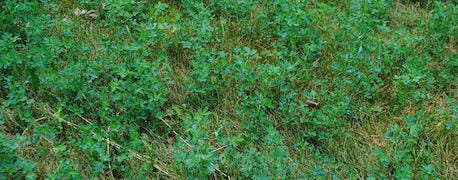July 5, 2012

"Good management of moisture stressed forages will increase maintenance of a good stand and reduce the loss of forage production," said Dan Undersander, University of Wisconsin-Extension forage agronomist. "Management of alfalfa, grass hayfields, and pasture each have some special considerations."
For those with drought-stressed alfalfa, decisions must be made about the next cutting. Undersander, has several recommendations.
A primary question is whether to cut or not. Drought stressed alfalfa flowers at a shorter height than normal. Alfalfa should generally be cut for yield, not to encourage regrowth,

TO CUT OR NOT TO CUT: Alfalfa should generally be cut for yield, not to encourage regrowth, according to Dr. Dan Undersander, UW-Extension forage agronomist. Photo by Fran O'Leary
Undersander said. "New growth won't come from the part of the plant that has flowered, but will come from new shoots from the crown of the plant when sunlight stimulates new bud development."
Because of the way alfalfa responds to drought stress, Undersander said cutting would not encourage regrowth unless growth is thick and tall enough to shade the alfalfa crown - this usually means that there is sufficient tonnage to make harvest worthwhile.
"If plants are tall and thick enough to make for a decent harvest, then go ahead and cut, Undersander said. "Cut drought stressed alfalfa 50% to 100% flower. If you can see through to the crown of the plant, don't cut. Sunlight is reaching the crown and new buds will develop. If the plants are 10 inches or less with flowers, let it regrow on its own, without clipping. The regrowth will come up through the short flowering plants and produce more yield. Also, farmers should remember that alfalfa that is 8 to 10 inches tall will be very high in quality even if it ripens to have seed heads because of the large amount of leaves in relation to the amount of stem."
Don't touch
"New seedlings that are drought-stressed should be left alone until August," he said, "unless mowing is necessary to reduce weeds. But if a new stand is pure alfalfa, let it go."
Plants respond differently to drought stress, according to Undersander. The quality of legumes such as alfalfa goes up in these conditions. In contrast, grasses lose quality in drought. They put out more stem and heads, making for lower quality feed value. Producers must adjust their feeding of livestock accordingly. For high yields, alfalfa needs good moisture in the first two weeks of regrowth after cutting. Plants have flowered while short because they lacked essential moisture during early regrowth.
Pastures should be fertilized with 40 pounds nitrogen per acre and 5 to 10 pounds of sulphur per acre in early August to encourage fall growth. Such fertilization will mean an additional 1 to 2 tons per acre forages and an extra month or two of grazing.
In addition, he noted that if grazing corn or sorghum-sudangrass, consider potential for nitrate toxicity. This is especially likely to be a problem if growth was reduced to less than 50% of normal and/or high levels of nitrogen were applied. Samples taken for nitrate test must be frozen or analyzed immediately as nitrate will decline in tissue over 3 to 4 hours. If above toxic, levels feed hay or some other forage in the morning and graze corn a couple hours in the afternoon.
If you have additional questions or concerns about your drought stressed forages, contact Dan Undersander or your county Extension agriculture agent. Contact information for county UW-Extension agents can be found at www.uwex.edu/ces/cty
You May Also Like




